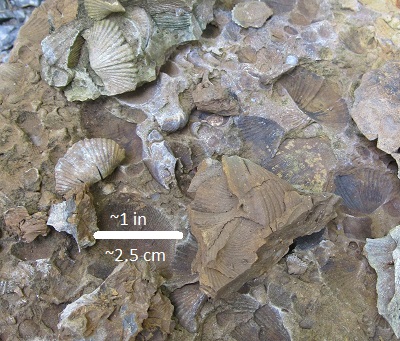It's Earth Science Week and Wednesday is National Fossil Day.
Dinosaurs get all the glory, but brachs are where it's at! West Virginia does not contain sedimentary rocks from the "Age of the Dinosaurs." Dinosaurs were alive in the Cretaceous, Jurassic, and Triassic Periods, which together comprise the Mesozoic Era. Except for relatively recent Quaternary deposits, West Virginia's sedimentary rock units are much older than the''Age of the Dinosaurs.'' West Virginia does have a few igneous intrusives that are Mesozoic and younger. A link to the Geologic Time Scale, as published by the USGS, showing age ranges for Precambrian, Devonian, Mesozoic, etc., is here.
The WVGES GeoEducation page has a wealth of information. Here is a section on the most commonly found fossils in West Virginia. In addition, the WVGES Mini-Museum page shows fossils dating from the Devonian, Mississippian, and Pennsylvanian, along with some younger fossils and dinosaur replicas. The museum is housed at the offices of the West Virginia Geological and Economic Survey (WVGES) and is curated by E. Ray Garton .
The study of fossils and past life is called Paleontology. Fossils are evidence of plant and animal life in the geologic past and they form in may ways. The most common fossils found in West Virginia were formed by molds, casts, and mineral replacement. Fossils formed by animals tend to be lumped into categories of ''body fossils'' or ''trace fossils.'' As the names imply, body fossils were formed from all or part of the animal itself, and trace fossils are the tracks, trails, burrows, feces, and feeding traces of animals.
Certain fossils can be important indicators to help geologists pinpoint the geologic time and perhaps even the specific formation they are observing. Some of the more unusual (and sometimes helpful) trace fossils we find in West Virginia include Pteridichnites biseriatus, Bifungites sp., and an unknown trace fossil. The Spirifer brachiopods shown below on this page are indicators of a specific member of the Price Formation.

A fantastic resource for body fossils in eastern West Virginia and nearby Virginia is found in
It is available as a free PDF download (warning: it's large) from the Virginia Department of Mines, Minerals and Energy (DMME) from this page.
The DMME web page for this publication references Part I of Bulletin 52, but the download also includes Part II - Fossil Plates and Explanations, an invaluable resource for those of us working in this part of Appalachia.
 WV Geological & Economic Survey
WV Geological & Economic Survey